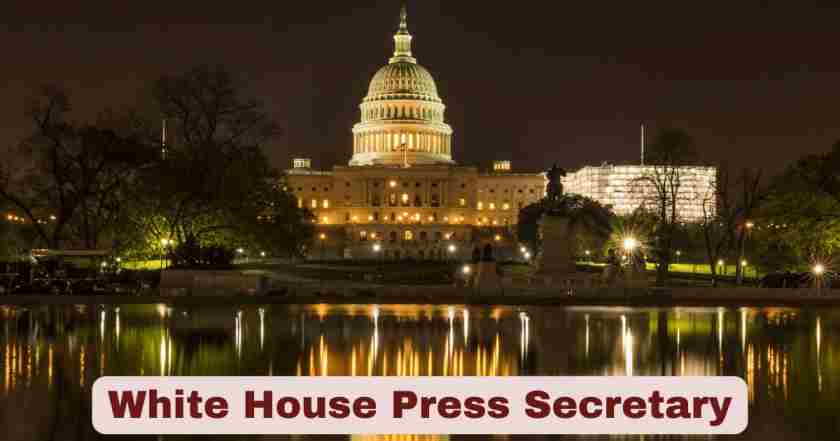1. White House Press Secretary
The White House Press Secretary serves as one of the most visible and influential positions in American government, acting as the primary spokesperson for the President and the administration. In 2025, this role continues to evolve with changing media landscapes and communication strategies that shape how the American public receives information from the highest levels of government.
| Key Aspects | Details |
|---|---|
| Reporting Structure | Directly to the President |
| Primary Function | Chief spokesperson and media liaison |
| Historical Significance | 36th person to hold this position |
| Current Position | 36th White House Press Secretary |
| Role Significance | Primary presidential spokesperson |
| Communication Scope | National and international media |
| Democratic Function | Government transparency and accountability |
| 2025 Evolution | Modern digital communication integration |
The White House Press Secretary position represents the cornerstone of presidential communication in the United States government structure. The press secretary serves as the primary intermediary between the President and the American media, facilitating the flow of information that ultimately reaches millions of citizens daily. This position holds immense responsibility in shaping public discourse and maintaining transparency in democratic governance.
The role encompasses multiple dimensions of communication, from daily press briefings to crisis management and strategic messaging. Press secretaries must possess exceptional communication skills, deep policy knowledge, and the ability to think quickly under pressure while representing the administration’s positions accurately and effectively.
2. Facts About White House Press Secretary
| Position Facts | Details |
|---|---|
| Establishment | Informal role since early 1900s |
| Official Title | White House Press Secretary |
| Salary Range | $180,000 – $200,000 annually |
| Tenure Average | 2-3 years per administration |
| Daily Briefings | Monday through Friday typically |
| Total Number | 36 people have held this position |
| Briefing Room Capacity | 49 seats for journalists |
| Working Hours | 12-16 hours daily during busy periods |
| Security Clearance | Top Secret clearance required |
| Staff Support | 15-20 communications team members |
The White House Press Secretary position has evolved significantly since its inception, adapting to technological advances and changing media consumption patterns. Understanding the fundamental facts about this position provides insight into its critical importance in American democracy.
The press secretary is responsible for collecting information about actions and events within the president’s administration and issues the administration’s reactions to developments around the world. This comprehensive responsibility makes the position one of the most demanding in government service.
Modern press secretaries must navigate complex media relationships while maintaining credibility across traditional news outlets, digital platforms, and social media channels. The position requires balancing transparency with strategic communication objectives, often under intense public scrutiny.
The position operates under intense public scrutiny with responsibilities that extend 24/7 during major national or international events. Press secretaries must maintain composure while delivering accurate information under pressure, often fielding dozens of questions from experienced journalists on complex policy matters.
Press secretaries handle an average of 200-300 questions per week from various media outlets, ranging from domestic policy inquiries to complex international relations matters. The role requires extensive preparation, with briefing books often containing 100+ pages of background information daily.
The position has seen both male and female holders, with representatives from various professional backgrounds including journalism, law, political campaigns, and government service. Each press secretary brings unique expertise while maintaining the institutional integrity of White House communications.
3. Who is the White House Press Secretary
| Personal Profile | Details |
|---|---|
| Full Name | Karoline Claire Leavitt |
| Birth Date | August 24, 1997 |
| Current Age | 27 years old |
| Political Experience | Campaign and communications roles |
| Education | Political science background |
Karoline Claire Leavitt is an American political spokesperson who has served since 2025 as the 36th White House press secretary under the second Trump administration. Her appointment represents a strategic choice reflecting the administration’s communication priorities and approach to media relations.
Leavitt brings a unique combination of political experience and communications expertise to the role, having previously worked in various political campaigns and communications positions. Her background provides her with practical understanding of both policy development and public messaging strategies.
The selection of a press secretary involves careful consideration of multiple factors, including communication skills, policy knowledge, political alignment, and ability to withstand intense public scrutiny. Press secretaries must demonstrate unwavering loyalty to the President while maintaining credibility with the press corps and the American public.
Her role extends beyond daily briefings to include strategic planning for major policy announcements, crisis communication management, and coordination with other administration officials on messaging consistency. The press secretary serves as a key advisor on how policy decisions will be received by the public and media.
4. White House Press Briefing Operations
| Briefing Components | Description |
|---|---|
| Opening Statements | Policy announcements and updates |
| Question Period | Direct media interaction |
| Follow-up Responses | Detailed policy clarifications |
| Technical Briefings | Specialized topic presentations |
| Emergency Sessions | Crisis communication protocols |
White House press briefings serve as the primary mechanism for regular communication between the administration and the American public through the media. The press secretary interacts with the media and the White House press corps on a daily basis, generally in a daily press briefing.
These briefings represent more than simple information sharing; they constitute a vital democratic institution that ensures government accountability and transparency. The briefing room serves as a forum for journalists to ask direct questions about policy decisions, administrative actions, and current events affecting the nation and the world.
This White House believes strongly in the First Amendment, so it’s why our team will work diligently to restore the press passes of the 440 journalists whose passes were wrongly revoked by the previous administration, demonstrating the current administration’s commitment to press access and freedom.
The format and structure of these briefings have been refined over decades to balance information dissemination with practical time constraints. Press secretaries must prepare extensively for each briefing, anticipating questions on a vast range of topics from domestic policy to international relations.
5. White House Press Briefing Schedule and Operations
| Schedule Elements | Timing and Frequency |
|---|---|
| Regular Briefings | Weekdays, typically early afternoon |
| Special Sessions | As needed for major announcements |
| Technical Briefings | Policy-specific timing |
| Crisis Communications | Immediate response protocols |
| Weekend Updates | Limited, emergency-based |
The White House press briefing schedule operates on a structured yet flexible framework designed to accommodate breaking news, policy announcements, and routine administrative updates. Understanding this schedule helps media professionals and the public know when to expect official communications.
White House Press Secretary Karoline Leavitt briefed reporters and responded to questions following President Trump’s announcement of 25% tariffs on Japan and South Korea starting August 1, 2025, demonstrating how briefings respond to immediate policy developments.
Regular briefings typically occur on weekdays, with timing adjusted based on the President’s schedule, breaking news events, and significant policy announcements. The flexibility of the schedule allows the administration to respond quickly to developing situations while maintaining consistent communication with the media.
Special briefings may be scheduled for major policy rollouts, crisis response, or when detailed technical information requires expert presentation. These specialized sessions often include subject matter experts alongside the press secretary to provide comprehensive information on complex topics.
6. Press Secretary Responsibilities and Daily Operations
| Daily Responsibilities | Time Allocation |
|---|---|
| Briefing Preparation | 3-4 hours |
| Policy Consultations | 2-3 hours |
| Media Interactions | 1-2 hours |
| Internal Meetings | 2-3 hours |
| Strategic Planning | 1-2 hours |
The White House Press Secretary’s responsibilities extend far beyond conducting daily briefings, encompassing a comprehensive range of communication functions that support the entire administration’s messaging strategy. These duties require extensive preparation, policy knowledge, and strategic thinking.
Daily operations begin hours before public briefings, with extensive preparation sessions involving policy experts, communication staff, and sometimes direct consultation with the President. Press secretaries must stay informed about all administration activities to accurately represent the government’s positions and respond to unexpected questions.
The role includes managing relationships with individual reporters, news organizations, and the broader White House press corps. Effective press secretaries balance accessibility with message discipline, ensuring that administration positions are communicated clearly while maintaining professional relationships with media professionals.
Coordination with other government departments and agencies forms another crucial aspect of the role. The press secretary must ensure consistent messaging across the entire executive branch, working closely with communications teams throughout the federal government.
7. Modern Media Landscape and Press Secretary Evolution
| Media Evolution | Current Adaptations |
|---|---|
| Traditional Media | Established protocols maintained |
| Digital Platforms | Expanded access and engagement |
| Social Media | Direct communication channels |
| Podcast Appearances | Long-form discussion opportunities |
| Influencer Relations | New audience reach strategies |
The White House Press Secretary role continues to evolve with changing media consumption patterns and technological advances that reshape how Americans receive news and information. Modern press secretaries must navigate traditional journalism alongside digital media platforms and social media engagement.
It’s essential to our team that we share President Trump’s message everywhere and adapt this White House to the new media landscape in 2025, highlighting the administration’s recognition of evolving communication channels and audience expectations.
Contemporary press secretaries utilize multiple communication channels simultaneously, from traditional press briefings to social media platforms, podcasts, and digital-first news organizations. This multi-channel approach ensures broader reach while accommodating diverse audience preferences for consuming political news and information.
The integration of new media voices represents a significant shift in White House communications strategy. Press secretaries must now engage with influencers, content creators, and non-traditional media figures who reach audiences that traditional news organizations may not effectively serve.
8. Press Briefing Room Innovations and Accessibility
| Room Features | Recent Improvements |
|---|---|
| Seating Capacity | Optimized for social distancing |
| Technology | Enhanced audio/video systems |
| Accessibility | Universal design implementation |
| Media Diversity | Expanded credential access |
| Broadcasting | Improved digital streaming |
The James S. Brady Briefing Room serves as the physical and symbolic heart of White House communications, representing the democratic principle of press freedom and government transparency. Recent innovations have modernized this historic space while preserving its essential function.
We’re also opening up this briefing room to new media voices who produce news-related content, demonstrating the current administration’s commitment to expanding media access and representation in White House communications.
Physical and technological improvements to the briefing room enhance both the experience for attending journalists and the quality of broadcast coverage reaching the public. Modern updates include improved lighting, audio systems, and digital infrastructure that support high-quality content production across multiple media formats.
Accessibility improvements ensure that journalists with disabilities can fully participate in briefings and ask questions. Universal design principles guide recent modifications to make the briefing room more inclusive for all media professionals covering the White House.
9. Crisis Communication and Emergency Protocols
| Crisis Types | Communication Protocols |
|---|---|
| National Security | Classified information handling |
| Natural Disasters | Coordination with emergency agencies |
| International Events | State Department collaboration |
| Domestic Policy | Legislative and judicial coordination |
| Health Emergencies | Medical expert consultation |
White House Press Secretaries must be prepared to communicate effectively during national crises, natural disasters, international incidents, and other emergency situations that require immediate public information. These scenarios test the press secretary’s ability to provide accurate, timely, and reassuring communication.
Emergency communication protocols involve rapid coordination with relevant agencies, fact verification processes, and strategic message development under extreme time pressure. Press secretaries must balance the public’s need for information with national security considerations and ongoing response efforts.
Recent examples of crisis communication include responses to international conflicts, domestic policy challenges, and global health emergencies. Effective crisis communication builds public trust and confidence in government’s ability to manage difficult situations while keeping citizens informed.
The press secretary’s role during emergencies extends beyond information sharing to include reassurance, explanation of government actions, and coordination with state and local officials. Clear, consistent messaging during crises can significantly impact public response and cooperation with emergency measures.
10. Historical Context and Press Secretary Legacy
| Historical Periods | Key Developments |
|---|---|
| Early 20th Century | Informal beginning |
| Mid-Century | Formal protocols established |
| Television Era | Visual communication emphasis |
| Digital Age | Multi-platform strategies |
| Social Media Era | Direct public engagement |
The White House Press Secretary position has evolved significantly since its informal beginnings in the early 20th century, reflecting changes in media technology, government complexity, and democratic expectations for transparency. Understanding this historical context illuminates the current role’s importance and continuing evolution.
Early press secretaries operated with minimal staff and limited formal protocols, gradually developing the structured approach that characterizes modern White House communications. Each press secretary has contributed to the role’s development, establishing precedents and practices that continue to influence current operations.
The position’s evolution mirrors broader changes in American democracy, including expanded media access, increased public engagement with politics, and growing expectations for government transparency. Modern press secretaries inherit a legacy of public service while adapting to contemporary communication challenges.
Notable press secretaries throughout history have left lasting impacts on the role’s development, establishing traditions of professionalism, accuracy, and dedication to public service. Today’s press secretaries build upon this foundation while innovating for future challenges in government communication.
11. Future of White House Communications
| Future Trends | Potential Impacts |
|---|---|
| AI Integration | Enhanced information processing |
| Virtual Reality | Immersive briefing experiences |
| Global Connectivity | International audience considerations |
| Real-time Demand | Immediate response expectations |
| Multimedia Content | Diverse format requirements |
The White House Press Secretary role will continue evolving as communication technologies advance and public expectations for government transparency and accessibility grow. Future press secretaries will likely navigate even more complex media environments while maintaining core democratic functions.
Emerging technologies including artificial intelligence, virtual reality, and advanced social media platforms will create new opportunities and challenges for White House communications. Press secretaries must balance innovation with traditional democratic principles of government accountability and press freedom.
Global communication trends, including increased demand for real-time information and multimedia content, will influence how future administrations structure their communication strategies. The press secretary role may expand to include new responsibilities related to emerging media formats and international communication requirements.
Training and preparation for future press secretaries will likely emphasize technological literacy alongside traditional communication skills. The role’s evolution reflects broader changes in how democratic governments communicate with citizens in an increasingly connected world.







